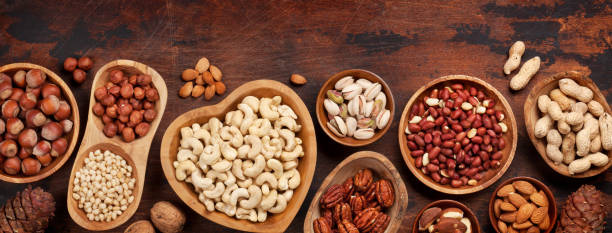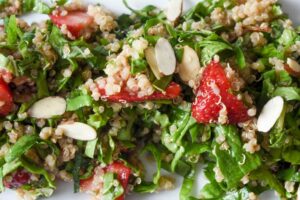Go Ahead, Eat More Nuts and Seeds
go.ncsu.edu/readext?1068977
en Español / em Português
El inglés es el idioma de control de esta página. En la medida en que haya algún conflicto entre la traducción al inglés y la traducción, el inglés prevalece.
Al hacer clic en el enlace de traducción se activa un servicio de traducción gratuito para convertir la página al español. Al igual que con cualquier traducción por Internet, la conversión no es sensible al contexto y puede que no traduzca el texto en su significado original. NC State Extension no garantiza la exactitud del texto traducido. Por favor, tenga en cuenta que algunas aplicaciones y/o servicios pueden no funcionar como se espera cuando se traducen.
Português
Inglês é o idioma de controle desta página. Na medida que haja algum conflito entre o texto original em Inglês e a tradução, o Inglês prevalece.
Ao clicar no link de tradução, um serviço gratuito de tradução será ativado para converter a página para o Português. Como em qualquer tradução pela internet, a conversão não é sensivel ao contexto e pode não ocorrer a tradução para o significado orginal. O serviço de Extensão da Carolina do Norte (NC State Extension) não garante a exatidão do texto traduzido. Por favor, observe que algumas funções ou serviços podem não funcionar como esperado após a tradução.
English
English is the controlling language of this page. To the extent there is any conflict between the English text and the translation, English controls.
Clicking on the translation link activates a free translation service to convert the page to Spanish. As with any Internet translation, the conversion is not context-sensitive and may not translate the text to its original meaning. NC State Extension does not guarantee the accuracy of the translated text. Please note that some applications and/or services may not function as expected when translated.
Collapse ▲
You’re hungry. Looking for a snack. How about grabbing a handful of nuts or seeds? For years dietitians and people looking to eat more healthful have looked down upon these foods saying they aren’t healthy. Not so any more.
Carolyn Dunn, PhD, RDN, LDN the William Neal Reynolds Distinguished Professor Emerita at NC State University recently wrote about these foods in the Eat Smart Move More Prevent Diabetes blog. Dr. Dunn says we should never have taken seeds and nuts out of our diets.
According to Dunn, “the type of fat found in nuts and seeds is healthy unsaturated fat which has been shown to decrease the risk of heart disease, stroke, and some forms of cancer.” Also, some nuts and seeds have omega 3 fat which has been shown to have a protective effect for chronic illnesses including heart disease. They both have a unique combination of healthy fat and antioxidants that decrease inflammation and protect your brain.
However, they are still high in fat and calories which is why portion control is the key. The current recommendation is only one-ounce a day. That’s going to take some willpower because one-ounce is about ¼ cup or a small handful.
In moderation, nuts and seeds can help with weight control and maintenance. Nuts have protein which helps to maintain lean body mass. People tend to feel full longer after eating nuts, which can help you to not overeat.
Which nuts and are the healthiest? According to the blog, all nuts and seeds are healthy choices, but several do have their own unique qualities.
- Walnuts, chia seeds, and flax seeds are higher in omega 3 fat than other nuts and seeds.
- Pistachio nuts have been shown to have a positive impact on the brain.
- Almonds are higher in Vitamin E than other nuts.
- Peanuts (which are technically a legume) are usually lower in cost than many other nuts but have many of the same health promoting qualities.
In addition to snacking, adding nuts and seeds to foods that your already eat and love can be a great way to get more into your diet. They can add crunch and flavor to soups, salads, yogurt, cereals and oatmeal.
Here’s a recipe from Med Instead of Meds that incorporates nuts along with whole grains, fresh greens and strawberries. Perfect for this time of year. Another bonus is that quinoa is high in protein and the flavor compliments the nuts. Use any greens you like but they recommend baby spinach and arugula or a combination.
 Quinoa Strawberry Salad
Quinoa Strawberry Salad
Dressing:
- 2 tablespoons balsamic vinegar
- 1 teaspoon Dijon mustard
- 2 tablespoons olive oil
- Salt and fresh ground pepper to taste
Salad:
- ½ cup dry quinoa
- 2 cups baby spinach leaves, chiffonade
- 2 cups arugula, chiffonade
- ⅔ cup sliced strawberries
- 2 tablespoons sliced almonds, toasted
- 1 handful of fresh basil leaves, chiffonade
Place quinoa in medium saucepan along with 1¾ cups water. Bring to boil, then cover and reduce heat to simmer for 15 minutes or until cooked. Remove lid and cook until all water is evaporated. Remove from heat. Make the dressing by combining all ingredients in a bowl or jar. Place the quinoa, spinach, arugula, strawberries, toasted almonds, and basil in bowl and combine. Add and toss in dressing just prior to serving. Makes 4 servings about a cup each. Each serving contains 5 grams of protein and 182 calories.
Eat Smart, Move More, Prevent Diabetes is a CDC-recognized online provider of the National Diabetes Prevention Program. The program focuses on evidence-based strategies to achieve a healthy weight and prevent or delay the onset of type 2 diabetes. This program was developed by NC State University and the NCDHHS Division of Public Health. They offer frequent blog posts on smart eating, moving more, preventing diabetes and living mindfully.
Med Instead of Meds was also created by a group of nutrition and health professionals from NC State University and NC Division of Public Health. Eating the “med way” (also known as the Mediterranean Diet) has been proven to protect against chronic illness. In some cases, it may even result in decreasing medications taken for blood pressure, high cholesterol, or diabetes. Hence the name Med Instead of Meds. Information, videos and lots of recipes are available at the Med Instead of Meds website.
Resources
- Eat Smart, Move More, Prevent Diabetes: Are Nuts and Seeds Healthy?
- Eat Smart, Move More Prevent Diabetes: Nut Butter Buying Guide
- Med Instead of Meds: Rosemary Chili Walnuts
- Med Instead of Meds: Med Meringues
- Med Instead of Meds: Quinoa Strawberry Salad
Syracuse is a Family and Consumer Science team member and can be reached at N.C. Cooperative Extension, Brunswick County Center 910-253-2610 or clsyracu@ncsu.edu



